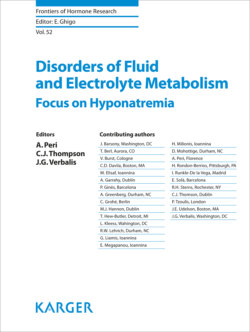Читать книгу Disorders of Fluid and Electrolyte Metabolism - Группа авторов - Страница 9
На сайте Литреса книга снята с продажи.
Early Publications and Theories
ОглавлениеAlthough there have been a number of papers that referred to hyponatremia in the context of water intoxication, the first systematic review of conditions marked by abnormalities of water and salt balance in PubMed was published in 1947 in the British Medical Journal [1]. Marriott’s treatise focused on the prevailing interpretation of the time, that perturbations in serum [Na+] concentration could be explained on the basis of altered dynamics of sodium balance; in other words, that abnormal sodium intake or excretion was responsible for changes in serum [Na+] concentration, including hyponatremia. This view, which predominated the field for many years, is in direct contrast to modern interpretations of the pathophysiology of hyponatremia, which dictate that abnormalities of water handling, as mediated by the antidiuretic actions of arginine vasopressin (AVP) are responsible for a large number, if not most cases of hyponatremia [2]. The lack of awareness of the important role of water retention in hyponatremia was reflected in the first case series of patients who had hyponatremia complicating pulmonary tuberculosis [3]. Published as an abstract of a presentation to the American Society for Clinical Investigation, this paper detailed the clinical characteristics of 10 patients with advanced pulmonary tuberculosis, complicated by malnutrition, in whom hyponatremia (plasma sodium 123–130 mEq/L) was associated with elevated urine [Na+] concentrations. The clinical observations indicated that there was no “frank evidence” of renal or adrenal disease, though two patients did test positive for adrenal insufficiency, using the archaic Levy-Power-Kepler test. The authors documented renal retention of sodium in 4 patients who were administered desoxycorticosterone, which raises the possibility that some of the patients were aldosterone deficient, perhaps due to tuberculous adrenalitis; 2 patients had recovery of serum [Na+] with improvement of their clinical condition, which suggests the possibility of the syndrome of inappropriate antidiuresis (SIAD) rather than adrenal failure. The authors concluded that the underlying pathophysiology was due to the “primary reduction in intracellular osmolality,” and hypothesized that the increased renal sodium excretion reflected a homeostatic attempt to reduce extracellular tonicity to equilibrate with the reduced intracellular osmolarity. It is likely, without the full diagnostic criteria that we would consider essential today, that the case series was heterogeneous, with some patients having tuberculous adrenal destruction, and perhaps more having straightforward SIAD. However, despite the fastidious clinical documentation of the series, there was no stated awareness of the possibility of altered water excretion, either due to cortisol deficiency or excess AVP secretion, which are far likelier candidate pathophysiologies based on our current understanding of hyponatremia.
In subsequent years, the association of hyponatremia with hepatic cirrhosis [4] and congestive cardiac failure [5] were formally documented, but a key step forward came with the first description of what we now understand as the commonest cause of hyponatremia, SIAD.
